Pasture Champions: Will Fulford, Lofftwen Farm, mid-Wales
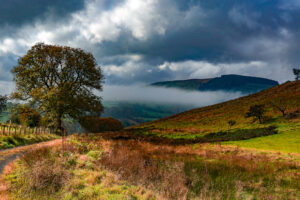 Lofftwen farm mid-Wales
Lofftwen farm mid-Wales
Tell us about your farm, its location, size, altitude, climate, soils, enterprises, organic/PfL/other status
320-acres situated on the eastern edge of the Cambrian mountains in mid-Wales, with a south-easterly aspect overlooking Llanwrtyd Wells, known as “the smallest town in Britain” approximately 0.5 miles to the south in the Irfon Valley. Altitude ranges from about 220m rising to 440m. There is very little flat ground making it difficult to farm with modern machinery. The climate is close to temperate rainforest in terms of rainfall, and we have a wonderful array of mosses, ferns, and lichens as a result. The soils that underlie much of the farm are well drained stony loams on steep slopes with occasional rocky crags or outcrops.
Originally, we were looking for a project to restore ancient woodland on a commercially planted site. But when we were introduced to Lofftwen farm in 2016 we fell for it immediately, despite the fact it had no woodland to speak of.
We have since planted around 130,000 trees across 32 different species on about 110 acres. We never intended to get into farming, although we always wanted animals as part of the mix for ecological reasons. But taking that step felt like a huge responsibility as we have no farming background and are not living on the farm (yet).
Being introduced to the PFLA via Knepp was instrumental in speeding up this process, and thanks to Emma (PFLA Cymru Facilitator) and her contacts, we now have 5 pedigree Hereford bulls on loan outwintering and doing an incredible job breaking up areas of thick sward and scrub.
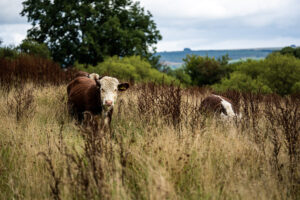 Outwintering pedigree Traditional Herefords - on loan!
Outwintering pedigree Traditional Herefords - on loan!
Our farm is also home to four Eriskay ponies, a crazy farm cat, and a handful of chickens that keep playing hide and seek with their eggs! We plan to increase livestock on the farm in the future and play our own part in contributing to local food systems which has emerged as an essential part to fulfilling our original ecological goals.
Share with us a general description of the biodiversity on your farm – essentially above ground (but reference to below ground if relevant) – both flora and fauna
The farm is a mosaic of different habitats, from ancient hedgerow trees to new woodland, plenty of scrub, unimproved acid and mesotrophic grasslands, upland peatbog and heath, and lowland seasonal wetland/semi-improved grasslands. To-date, we have identified over 70 species of birds, 50 wildflowers, 30 grasses/sedges/rushes, and 20 ferns/mosses/lichens alongside the usual mammals, badgers, foxes, stoat, weasel, hare. Some of our favourite birds include pied flycatcher, tree pipits, and even the odd whinchat.
The presence of whorled carraway is exciting as it suggests ancient meadows waiting to be restored.
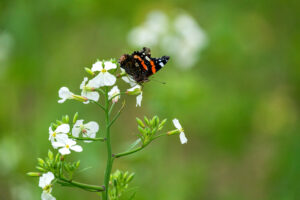 wild raddish post winter bird food planting
wild raddish post winter bird food planting
What do you do to encourage this biodiversity?
Almost everything we do is about encouraging biodiversity, from the birdboxes and winter bird seed, to blocking drainage channels and rewetting the land, to maintaining ancient trees and planting new ones.
It’s exciting to think about the changes we’re going to see in the years ahead, particularly the impact of bringing more livestock back onto the farm and breaking up the new planting.
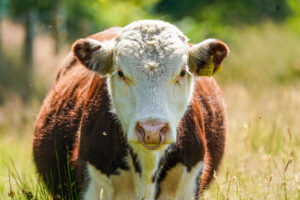 Traditional Hereford bull recently introduced
Traditional Hereford bull recently introduced
How is it connected across the farm and beyond?
We have restored about 1000m of hedgerow and are planning another 3000m to connect up different parts of the farm.
What are the benefits to the farm and is it increasing its climate and business resilience? If so, in what way?
It is too early to say, but that is certainly the plan. We know from recent surveys that the number of bird species has increased 43% at Lofftwen since May 2017. We expect these numbers to continue increasing, but we are also aware that we make decisions without always understanding the full consequences.
The important thing is that we continue to monitor the impacts of our decisions over the long-term and stick to the idea of a mosaic of dynamic habitats.
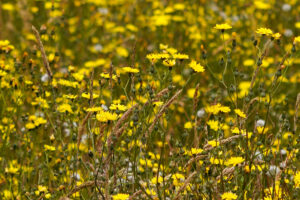 Wild flowers returning
Wild flowers returning
How do you monitor it?
We conducted a Phase 1 habitat assessment in May 2017. This has given us a good baseline of information and we plan to repeat this every 5 years. But we would love to do more monitoring, particularly of insect populations. We just don’t have the resources or expertise at present, but are working on developing partnerships with universities and other organisations.
Are there any benefits to the farm that are directly attributable to the Pasture for Life approach and/or would be lost if there were no ruminant animals on the farm? In brief, what are the benefits from having ruminant animals on the farm?
It is very early days as the cattle only arrived in July and their numbers are so small. However, we are managing them in rotation every few days using electric fencing, and the early anecdotal signs are really encouraging. The cowpats are riddled with insect holes, and their movements have created valuable potential habitat for the likes of curlew, snipe and marsh Fritillaries to move into.
One evening as the sun was setting you could see the bats circulating over the cattle picking off the insects. None of these things that are so important to ecosystems and biodiversity would be happening if the cattle weren’t here.
So even at this early stage and in these small numbers they seem to be having a hugely positive impact.
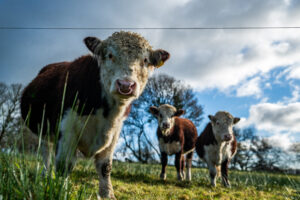 Winter residents
Winter residents



